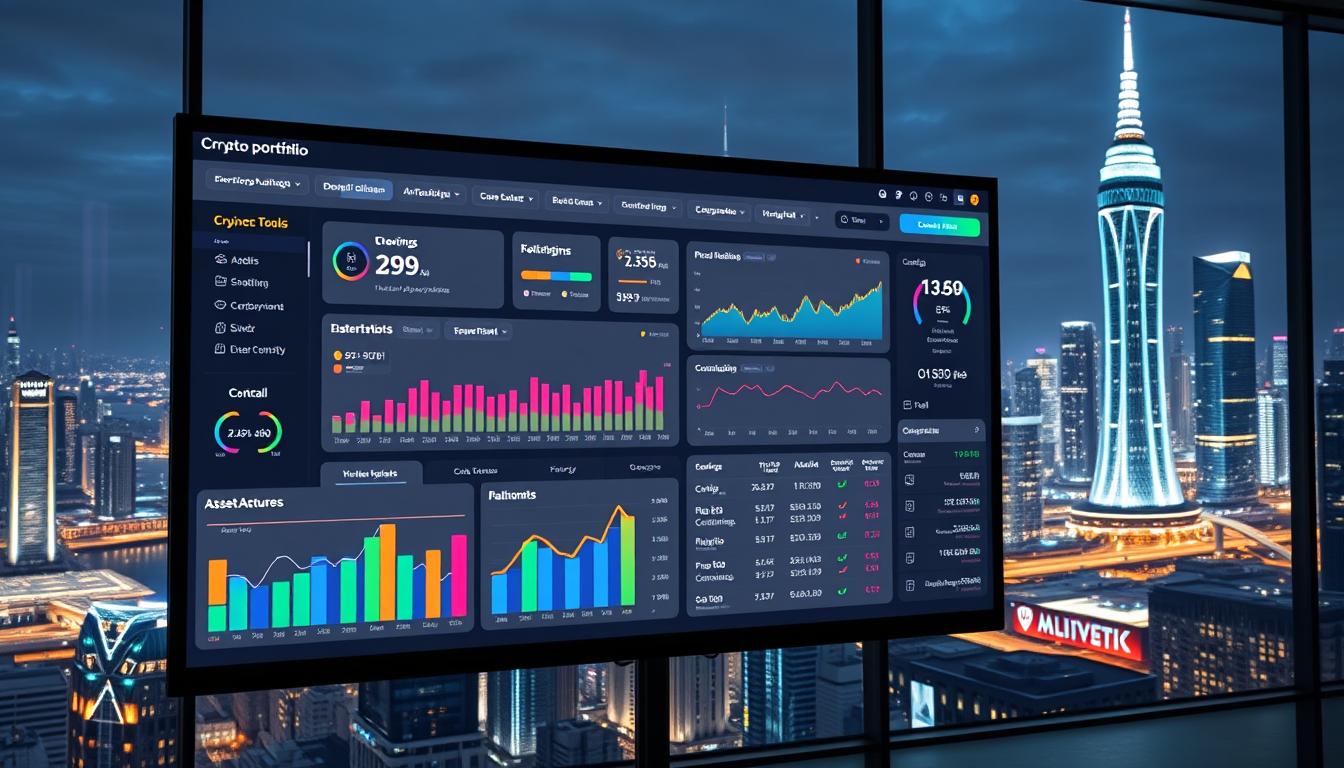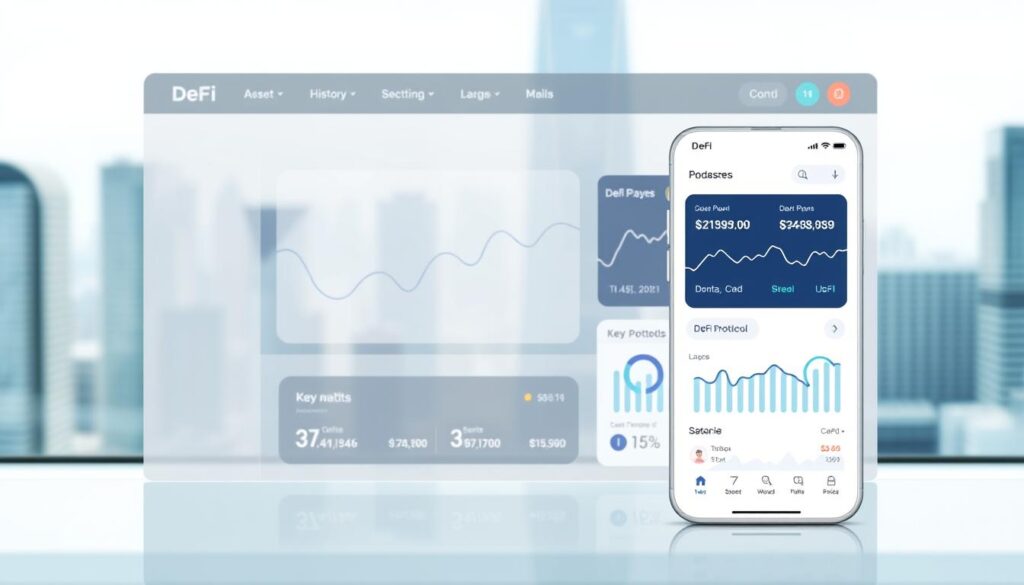Now Reading: Discover AI Crypto Portfolio Management Tools and Platforms
- 01
Discover AI Crypto Portfolio Management Tools and Platforms
Discover AI Crypto Portfolio Management Tools and Platforms

This guide helps U.S.-based investors compare options that centralize tracking, alerts, and analytics for digital assets.
You’ll see how leading services such as CoinStats, CoinGecko, CoinMarketCap, Crypto.com, CoinTracker, CryptoCompare, Kubera, Delta, Crypto Pro, Token Metrics and 3Commas fit different needs.
Expect clear criteria for risk, automation depth, tax workflows, API coverage, and security. The goal is to match features with user types: active traders, long-term allocators, DeFi-native users, and high-net-worth investors.
We explain differences among trackers, trading terminals, and automation suites. Practical notes cover integrations, pricing hints, and best pairings—such as combining a portfolio tracker with an automation service and a net-worth aggregator to streamline reporting and decisions.
Key Takeaways
- Unified dashboards speed decision-making and simplify tax records.
- Institutional custody has grown in the U.S., EU, and Singapore.
- Automation reduces manual work and enforces rebalancing discipline.
- Pick features by need: execution, reporting, or net-worth aggregation.
- Profiles include integrations, security practices, and pricing cues.
Why AI-driven crypto portfolio management matters in the present market
Large financial firms now treat digital assets like any other institutional holding. This change raises expectations for custody, reporting, and operational rigor in the U.S., EU, and Singapore.
Institutional adoption and pro-grade custody in the U.S.
Regulators and custody providers expect audit-ready records, compliance-ready exports, and robust APIs. Institutional traders demand systems that log access, produce reports, and preserve chain of custody for every asset.
From manual spreadsheets to automated, multi-asset oversight
Maintaining spreadsheets across exchanges wallets creates slow decision cycles and frequent errors. Teams miss arbitrage and suffer execution delays in volatile market moves.
- Real-time data is critical for performance monitoring; latency increases slippage and reduces trade quality.
- Diversified exposure—stablecoins, altcoins, staking, DeFi—adds operational complexity across multiple accounts.
- Automation enforces rebalancing, hard risk thresholds, and removes human bias during stress events.
- Fragmented tooling raises security risk when credentials and controls are inconsistent.
In practice, professional traders prefer systems with exportable audit trails, strong API coverage, and policy-driven access. The move from spreadsheets to automated oversight is not just convenience; it delivers institutional-grade precision and resilience for today’s fast-moving market.
What AI crypto portfolio management tools and platforms actually do
Today’s systems pull exchange and wallet activity into one dashboard so users see live P&L and allocation at a glance.
Real‑time performance, allocation, and trade analysis
These services connect accounts, normalize price feeds, and present unified dashboards that show position‑level detail and overall performance.
They surface realized and unrealized gains, fees, and slippage, and export reports for tax or compliance review.
Automation: rebalancing, indexing, and strategy execution
Automation modes include periodic rebalancing, threshold triggers, and index construction to keep target weights in range.
Some providers add bot execution and backtesting features—Shrimpy’s Rewind is a good example—so users can validate strategies before committing capital.
- Connect accounts and reconcile transactions for accurate reporting.
- Measure drift from targets and run scenario analysis to compare returns and volatility.
- Use alerts, custom views, and exports to simplify tax prep and audits.
Smart suggestions use machine learning to spot patterns and propose adjustments, while seamless sync remains the baseline requirement for any reliable portfolio tracker.
For a practical comparison of leading options, see the best tools for crypto portfolio management.
Top platforms at a glance: trackers, trading terminals, and automation suites
For fast shortlists, services fall into three camps: execution-first suites, analytics-led trackers, and DeFi/native net-worth viewers. This layout helps U.S. users match features to workflow.
Automation-first: 3Commas, Shrimpy, BitUniverse
3Commas runs DCA and grid bots with TradingView signals across 16+ exchanges. It adds copy trading and portfolio controls for active traders.
Shrimpy focuses on automated rebalancing, index creation, stop-losses, and backtesting with its Rewind feature.
BitUniverse blends grid bots with a built-in portfolio tracker to simplify execution and oversight.
Analytics and tracking: CoinStats, CryptoCompare, CoinMarketCap, CoinGecko
CoinStats syncs exchanges, wallets, and NFTs while offering tax reports and P&L exports.
CryptoCompare serves institutional users with customizable dashboards and compliance-ready exports.
CoinMarketCap and CoinGecko provide broad market data and light-weight portfolio tracker features for market monitoring.
DeFi-native and net worth: Zapper, Kubera, Rotki
Zapper maps yield farms, tokens, and liquidity pools across chains for DeFi users.
Kubera aggregates bank accounts, real estate, stocks, wallets to show net worth in one view.
Rotki emphasizes local data storage, privacy, and open-source tracking for self-hosted workflows.
| Category | Representative services | Core strength | Best for |
|---|---|---|---|
| Execution suites | 3Commas, Shrimpy, BitUniverse | DCA, grid bots, rebalancing | Active traders seeking automation |
| Analytics trackers | CoinStats, CryptoCompare, CoinMarketCap, CoinGecko | Market data, dashboards, exports | Users needing oversight and reporting |
| DeFi / net worth | Zapper, Kubera, Rotki | Multi-chain visibility, privacy, aggregation | DeFi users and HNW investors |
Quick guidance: active traders favor terminals and bots; long-term allocators pick rebalancers; DeFi users prefer multi-chain visualizers. Combine an execution suite with an analytics service to cover both oversight and trade execution.
Editor’s picks: standout crypto portfolio and management tools for different users
Below are editor picks that map specific user needs to services that shine in execution, reporting, or multi-chain visibility.
Active traders and bot users
3Commas offers DCA and grid bots with TradingView signals for fast execution across exchanges. Altrady adds a multi-exchange terminal with signal bots for low-latency order routing.
Use Coin Market Manager alongside them for trade journaling and analytics to review strategy performance.
Long-term investors and HNW
Shrimpy fits index-style investing, periodic or threshold rebalancing, and low-maintenance strategies. Kubera aggregates brokerage, real estate, bank accounts, and wallets to show total net worth.
DeFi-native portfolios
Zapper displays multi-chain yield, LP positions, and NFT holdings in one view. For privacy-first pros, Rotki stores data locally and exports audit-ready reports without third-party dependencies.
| User type | Recommended service | Key benefit |
|---|---|---|
| Active traders | 3Commas, Altrady | Signal-driven automation, multi-exchange execution |
| Long-term investors | Shrimpy, Kubera | Rebalancing, net-worth aggregation |
| DeFi natives | Zapper, Rotki | Multi-chain visibility, local data privacy |
- Factor total cost of ownership, including platform and exchange fees.
- Match features like alerts, backtesting, and automation templates to your strategy complexity.
- Maintain strict risk discipline: stop-losses, position sizing, and diversification.
CoinStats: unified crypto portfolio tracker with tax reporting and P&L
For traders and long-term holders who juggle multiple accounts, CoinStats makes tracking simple and accurate.
CoinStats consolidates holdings from centralized exchanges, DeFi wallets, and NFT collections into a single dashboard. The interface shows unified P&L, allocation, and custom alerts so users spot risks or opportunities in real time.
Sync across exchanges, wallets, NFTs
The service uses API-based syncing to pull trades, transfers, and balances. That reduces manual entry and keeps cost basis and transaction history aligned for tax work.
When CoinStats fits vs. execution-focused platforms
CoinStats is analytics-first. It shines at reconciliation, tax reporting, and performance breakdowns rather than order execution.
- Key features include watchlists, performance charts, and custom alerts.
- Supported assets span thousands of tokens, NFTs, and multi-chain wallets with mobile and desktop support.
- Ideal users: active traders who need deep analytics, long-term investors consolidating accounts, and NFT collectors seeking full visibility.
Tip: Pair CoinStats with an automation suite if you require bot execution, periodic rebalancing, or live trading rules while keeping analytics and tax-ready exports centralized.
Shrimpy: automation for rebalancing, indexing, and stop-losses
Shrimpy automates rebalancing, dynamic indexing, and portfolio stop-loss rules with precise controls for weighting, thresholds, and schedules.

Backtesting, “Rewind,” and vaulted history
Rewind shows a snapshot of holdings at any point since signup so users can inspect past allocation and outcomes.
Backtesting and simulations use live exchange data to validate strategies before committing capital. The Data Vault records complete account history and lets you filter by action, asset, or trade type for audit-ready review.
Pricing, API access, and multi-account execution
The Zero tier supports entry-level testing. The Plus plan ($49/month or $39/month billed annually) unlocks dynamic indexing, DCA, portfolio stop loss, and api access across up to 25 exchanges and 10 portfolios per exchange.
Shrimpy can run distinct strategies on multiple accounts at once. Consider fees and refresh time if you need tighter execution in volatile markets.
Security posture and access controls
Shrimpy stores API keys with FIPS 140-2 validated HSMs and recommends least-privilege API scopes. Only read and trading permissions are required.
Enable two-factor authentication to reduce custody risk. Combined with scoped keys, this provides a practical security posture for traders, long-term allocators, and analysts who value deep historical performance review.
3Commas: AI-enabled crypto trading bots with portfolio controls
3Commas is a leading automation suite that blends DCA and grid frameworks for both accumulation and volatility harvesting. It ships configurable bots and Smart Trades so traders can apply repeatable rules across accounts.
DCA and grid bot strategies for allocation and risk
DCA bots are commonly used for steady accumulation of BTC and ETH. Users set amounts, schedules, and safety order logic to smooth entry costs.
Grid bots work well for volatile pairs such as SOL and AVAX. Grid spacing, step sizes, and take-profit levels let traders capture range-bound moves while limiting downside with safety orders.
TradingView signals and multi-exchange support
The service integrates TradingView signals to trigger conditional orders. Custom indicators can call Smart Trades so strategy logic is transparent and repeatable.
3Commas connects to more than 16 exchanges. Multi-exchange connectivity helps diversify execution, access liquidity, and reduce downtime risk across venues.
- Configurable parameters: step size, spacing, take-profit, safety orders, max concurrent trades.
- Monitoring features: pause, tweak, or stop bots fast when markets shift.
- Use cases: DCA on majors, grid on altcoin volatility, hybrid capital segmentation across strategies.
- Best practice: pair with analytics services for P&L slicing, tax exports, and consolidated reporting.
| Feature | What it controls | Typical use |
|---|---|---|
| DCA bot | Scheduled buys, amount per order, safety orders | Long-term accumulation of BTC / ETH |
| Grid bot | Grid spacing, step size, take-profit | Harvesting volatility on SOL / AVAX |
| Smart Trades | Conditional orders, trailing stop, TP/SL combos | Event-driven execution from TradingView signals |
| Multi-exchange connectivity | API linking across venues | Reduce latency, diversify liquidity |
Who benefits: experienced traders who can configure, test, and iterate strategies responsibly. Keep risk parameters front and center and use analytics for deeper review.
DeFi-focused visibility with Zapper and privacy-first tracking with Rotki
For users focused on DeFi activity, visibility into wallet-level flows is essential for tracking real returns. Zapper and Rotki take different paths to that same goal: live discovery versus local custody of records.

Multi-chain positions, liquidity pools, and yield tracking
Zapper tracks tokens, liquidity pools, and yield farms across many blockchains in real time. It shows LP stakes, staking positions, vaults, and refreshed yield metrics at the wallet level.
Local data storage and self-hosted privacy workflows
Rotki is open-source and built for users who prefer local storage. It stores records on-device, supports exportable reports for compliance, and reduces exposure to cloud leaks.
- Zapper: best for DeFi discovery, live yield analytics, and multi-chain visualization.
- Rotki: best for on-device records, privacy-first workflows, and audit-friendly exports.
- Wallet-centric tracking aligns with on-chain transaction patterns for accurate performance reporting.
Builders, auditors, and security-focused operators often use both: Zapper for live monitoring and discovery; Rotki for archival accuracy and privacy. Note that DeFi-first services may have limited centralized exchange coverage, so a hybrid stack offers fuller oversight.
| Feature | Zapper | Rotki |
|---|---|---|
| Primary focus | DeFi discovery & yield view | Privacy-first local records |
| Data storage | Cloud-based, real-time feeds | On-device, self-hosted |
| Compliance support | Exportable snapshots for wallets | Exportable reports for audits |
| Best users | DeFi power users, LPs | Security-conscious professionals, auditors |
Kubera and net-worth aggregation across digital and traditional assets
For high-net-worth users, Kubera turns scattered holdings into a clear total-wealth view.
Kubera supports tracking of digital assets such as tokens and NFTs alongside bank accounts, stocks, and real estate. Personal plans start near $150 per year and include both automatic feed imports and manual entry for illiquid property or private equity.
The service surfaces top performers and laggards across asset classes, giving a fast read on which accounts or holdings drive net worth changes. That view helps users spot concentration risk and make informed allocation choices.
- Connections: bank and brokerage feeds, exchanges, wallets, and manual records for real estate.
- Use cases: estate planning, risk budgeting, family office reporting, and high-level capital allocation.
- Cost rationale: when decisions hinge on accurate totals, paying for reliable aggregation and clean data often pays for itself.
| Aspect | What Kubera shows | Best for |
|---|---|---|
| Coverage | Bank accounts, stocks, exchanges, wallets, NFTs, real estate | HNW individuals and family offices |
| Import modes | Automatic feeds, API links, manual entries | Illiquid holdings and aggregated reporting |
| Performance view | Top/bottom performers, historic net‑worth trend | Capital allocation and risk review |
Kubera works best alongside specialized trackers for execution, DeFi specifics, or tax exports. Use an analytics service for trade-level detail while keeping Kubera as the single source for total-wealth decisions.
Finally, expect strict credential hygiene and strong encryption from any service that consolidates sensitive data. Net-worth visibility aligns crypto exposure with broader financial goals and constraints for more disciplined decision-making.
Foundational features to compare before you choose a platform
Start by listing the analytics and automation you need so the choice fits your risk rules. A short checklist will reveal which services meet reporting, execution, and audit needs.

Risk metrics to demand
Prioritize risk analytics: dashboards should show VaR, max drawdown, Sharpe, beta, historical volatility, and correlations. These figures help reveal tail exposure and diversification benefits.
Automation depth and execution
Compare interval rebalancing versus threshold-based triggers. Look for dynamic indexing, event-driven orders, and bot integrations for near real-time adjustments.
Tax reporting, trade journaling, and export-ready data
Ensure native tax reporting and accurate cost-basis handling. Trade journaling services like Coin Market Manager import exchange history for win/loss ratios and behavioral analysis.
- Exportable reports: choose services such as CoinStats or CryptoCompare that provide audit-ready CSVs.
- Test first: trial with a sample account to verify analytics and exports match expectations.
- Control inputs: allow fee and slippage modeling so reported performance reflects realistic conditions.
Document use cases—systematic rebalancing or hybrid execution—so the chosen stack supports your strategies. For a practical comparison of tracking options, see the best crypto trackers.
Security and privacy practices to protect your assets and data
Before linking accounts, prioritize controls that limit damage if credentials leak. Strong basics reduce risk for all users and make audits simpler.
Two-factor authentication, encryption, and API key scopes
Enable two-factor authentication wherever offered. Use least-privilege API key scopes so an exchange cannot withdraw funds if a key is stolen.
Vendors that use hardware-backed encryption—for example, Shrimpy encrypts API keys with FIPS 140-2 validated HSMs and recommends 2FA and read/trade-only scopes.
Cold vs. hosted wallets, local data options, and audit trails
Cold storage reduces online attack surface for long-term holdings. Hosted wallets add convenience but raise platform risk; match choice to liquidity needs.
Rotki supports local storage and self-hosting for privacy-focused workflows. Many vendors provide exportable logs and audit trails for incident review and compliance.
- Rotate keys regularly and segregate accounts by strategy.
- Restrict access to necessary team members and keep secure backups.
- Review vendor pen tests, incident history, and security features before signing up.
Practical note: combine hardware-backed secrets, scoped API keys, and regular audits to raise security and improve operational management.
Integrations and API connectivity across exchanges and wallets
Reliable connections to exchanges and wallets are the backbone of accurate trade records and timely decision-making.

Robust API connectivity lets services sync transactions and balances from 300+ exchanges and popular wallets such as Coinbase and MetaMask. That sync creates near-real-time balance updates, unified allocations, and clearer P&L across multiple venues.
Centralized exchange coverage and DeFi wallet support
Broad exchange coverage and dependable wallet links reduce reconciliation gaps and cut manual work. CoinStats centralizes CEX, DeFi wallet, and NFT data while Rotki offers local storage with exportable compliance reports.
Third-party bot interoperability and signal automation
Many services interoperate with external bots via webhooks, signal bridges, or SDKs. 3Commas integrates with 16+ exchanges and consumes TradingView signals to enable continuous execution for active traders.
- Validate rate limits, pagination, and historical import quality to avoid missed trades or duplicates.
- Use stable OAuth or key-based connections and enable alerting for broken links or auth failures.
- Segment API keys by environment and role to follow least-privilege practices.
- Test exchange edge cases—delistings, fee types, and time-zone quirks—before relying on automated reports.
- Confirm exportable, normalized datasets for analytics, audit, and migration as needs evolve.
Smart strategies: rebalancing, allocation, and cross-exchange opportunities
Smart execution and disciplined rebalancing turn broad ideas into repeatable gains across exchanges.
Index-style investing and dollar-cost averaging
Index-style approaches spread exposure across sectors or asset categories and use periodic rebalancing to keep target allocation.
Shrimpy supports index-style investing, threshold rebalancing, stop-loss rules, and backtesting to validate assumptions before live runs.
Dollar-cost averaging (DCA) automates steady accumulation and reduces the impact of timing errors. 3Commas runs DCA and grid strategies with TradingView signals across 16+ exchanges.
Latency-aware arbitrage and execution considerations
Cross-exchange spread capture and triangular plays require low latency, deep order books, and smart routing to avoid slippage.
Practical execution choices — maker vs. taker paths, fee tiers, and slippage controls — materially affect realized performance.
| Strategy | Key drivers | When to use |
|---|---|---|
| Index & periodic rebalance | Target weights, thresholds, rebalancing cadence | Long-term allocation, reduce drift |
| DCA / grid | Schedule, step size, safety orders | Systematic accumulation, range-bound trading |
| Cross-exchange arbitrage | Latency, spreads, routing | High liquidity, low fees, fast execution |
- Monitor drift and set rebalancing thresholds to avoid overconcentration in rallying assets.
- Backtest and forward-test strategies to check volatility, correlation, and regime sensitivity.
- Apply stop-losses, position limits, and capital segmentation to guard against tail events.
- Pair automation with periodic human review, especially during market regime shifts.
Bringing it all together: choosing the right AI crypto portfolio management tools and platforms
Make selection decisions by matching real needs to real features, then test with small capital.
Define objectives, map required features, and shortlist two to three vendors. Try a limited allocation for 30 days to judge execution, risk controls, and tax reporting.
Many professionals combine 3Commas for automation, CoinStats for analytics plus tax reporting, and Kubera for net‑worth aggregation to cover execution, oversight, and wider financial context.
Prioritize security: check vendor controls, export quality, audit trails, and incident transparency. Confirm broad integrations across exchanges and DeFi so assets across multiple chains stay visible.
Document use cases, set clear success criteria, and schedule ongoing maintenance: key rotations, performance reviews, and parameter tuning. Factor platform and trading fees into expected returns before full adoption.
Next step: shortlist two to three top crypto candidates per category, run a 30‑day evaluation, and pick the combination that meets your strategy, risk, and reporting needs.












